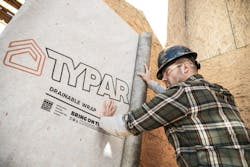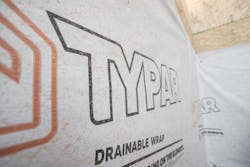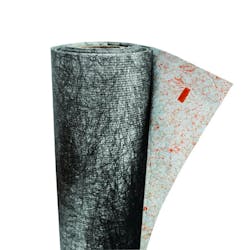Changing Building Codes Driving the Use of Drainable Building Wraps
In many areas around the country, building codes are driving the need for better moisture management solutions. The International Residential Code (IRC) has long required the use of water-resistive barriers (WRBs), but some states have recently added even more prescriptive measures to their codes that now mandates the use of rain screens. For example, residential building projects in Oregon are required to have rain screens in addition to a water-resistive barrier, when the state adoption the 2014 Oregon State Residential Specialty Code Section R703.1.
Rain screens have traditionally been achieved through the use of furring strips that separate the WRB from structural sheathing and framing, but new technologies have emerged that are helping to simplify this process. Most notably, the additional step of creating a drainage gap between the cladding and WRB can be eliminated if builders use a WRB that achieves 75 percent or greater drainage efficiency, in accordance with ASTM 2273.
With a growing number of products hitting the market to address this need, it’s important for builders and contractors to understand how each performs in order to specify the right building wrap for their project. In this piece, we will cover the growing adoption of drainable WRB’s and their role in managing bulk water intrusion.
Drainage Efficiency
At the cutting edge of today’s drainable technologies are new WRB products that integrate drainage gaps into the material itself through creping, embossing, weaving, or filament spacers. From a performance standpoint, drainable WRB's can achieve 90 percent or greater drainage efficiency without sacrificing any of the durability and ease of installation benefits builders and contractors have come to expect from premium housewraps. TYPAR® Drainable Wrap™ adds an additional layer of moisture control by being vapor permeable, meaning not only will it drain bulk water, but the material will allow walls to breathe allowing moisture vapor to escape. The product is also contractor-friendly and can be installed in any direction due to a layer of randomized integrated polypropylene fibers.
Proper installation is key
No matter how many benefits it offers, a WRB must be properly installed in order to do its job. Housewrap should be installed from the foundation upward, making sure to overlap joints with the higher course overlapping the lower. All horizontal seams should overlap a minimum of 50 mm (2 in.), and vertical seams at least 150 mm (6 in.). Installers must keep in mind that horizontal laps are just as important as vertical laps because windblown rain can travel sideways, or even up and over a properly installed lap. Manufacturer-recommended tape should be used to cover any tears and holes, and galvanized roofing nails or plastic cap nails should be used to attach the WRB to the structural sheathing and framing.
When installed as a complete system, some WRB products offer added assurance in the form of extended warranties. For example, the TYPAR® Weather Protection System consists of a WRB, flashings, and construction tape collectively covered by a lifetime limited warranty for both materials and labor. When in doubt, it is important to check the manufacturer’s website for additional guidance.
Conclusion
Advances in technology and building codes are driving adoption of better moisture management systems. The building industry is also starting to realize the race toward a ‘waterproof’ wall assembly is a fantasy, with design professionals now looking for smarter strategies for managing unwanted moisture and helping walls to dry when they inevitably get wet.
Today’s drainable housewrap products offer a powerful new defense against the elements by adding drainage capabilities to a solid mix of water resistance, durability, and breathability.


